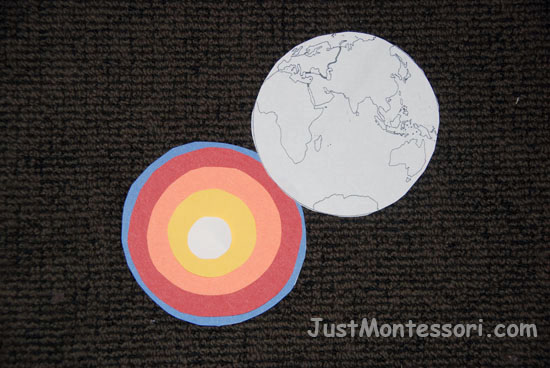Book choices for today:
Castles Stephanie Turnbull
Castle Richard Platt
A Year in a Castle Rachel Coombs
Science: (first circle)
Need for lesson – Continent globe, model of the Earth showing layers (I made one using play doh), and Parts of the Earth Booklet.
Science 65
When we look at this model of our Earth, what do we see? Land – continents and water – the oceans. What is inside our Earth, the part we cannot see? When you dig a hole in the ground with a shovel what do you see? As you dig deeper and deeper a shovel wouldn’t work so well. Scientist, called geologist have used massive drilling equipment to dig down deep deep into the Earth. They discovered that the earth has layers.
This is a play doh model of the Earth. We see the land and water. This is the outer layer of the earth called the crust. The crust goes deep inside our Earth. I am going to cut this play dough model of the Earth so we can see the next layer. The deeper you go into the Earth, the hotter it gets. The next layer, after the crust, is called the mantle. The mantle part of the Earth is made out of melted rock called magma.The mantle part goes even deeper than the crust part of the Earth. Next comes the outer core where it is even hotter. The outer core is the only liquid layer part of the of the Earth. Lastly we find the inner core – right down in the middle of the Earth. This is the very hottest part. In this play dough model the color orange is showing us how the mantle is beginning to get hotter and liquefy.

Earth Layers

Layers of the Earth Booklet
Additional Works:
Paper Layers of the Earth – Using the hemisphere map pieces, children can glue blue, red, orange, yellow, and white circles to make the layers.
Simple Subtraction – These are Earth erasers.

Paper Layers

Simple Subtraction
Practical Life:
Transfer – Earth Balls

Tongs
Geography: (second circle)
Need for lesson – Any Europe topic you would like to highlight and/or an art project. This lesson is about Medieval and Victorian Times.
Geography 42
The continent we are talking about now is Europe. Some people who visit Europe like to go and visit some of the old castles that are there. Castles were built a long time ago. The first thing that distinguished a castle was the ditch or moat around it. Most were filled with deep water to help protect those inside the castle. The only way to cross the moat was on the drawbridge. These wooden structures would be raised and lowered to cross over. Ropes or chains were attached to the end of the bridge and rigged to a pulley for the guards to lift and lower it. Castles also have kitchens and a room called the great hall where everyone ate. Towers allowed for people to look about and keep watch outside the castle walls. Many different people lived in and around a castle. An Atilliator was a skilled castle worker that made crossbows. A Castilian was the resident owner or person in charge of the castle. A castle would have watchmen and knights. The knights were professional soldiers. Other people who lived in a castle were the cooks and messengers. When castles were busy and active a long time ago, is known as the Medieval Times. Would you like to visit a real castle someday?
Another period of time was called the Victorian Period. This came many years after the Medieval Times. Victorian Times mean during Queen Victoria’s rule. She was the queen of Britain over 150 years ago. She at one time also lived in a castle. Britain is a country in Europe. What was it like during Victorian Times? Well, they didn’t have electricity so they used gas lamps and candles for light. There were no cars so people either walked, traveled by boat or train, or used coach horses to get around.
Europe has many old things that one can go and visit today. We say Europe has a lot of History.

Castle

Victorian Times Women’s Clothing
(These are paper dolls that I laminated and added pieces of Velcro on the backs)
-
 (H) Weeks 27-30$25.00
(H) Weeks 27-30$25.00


